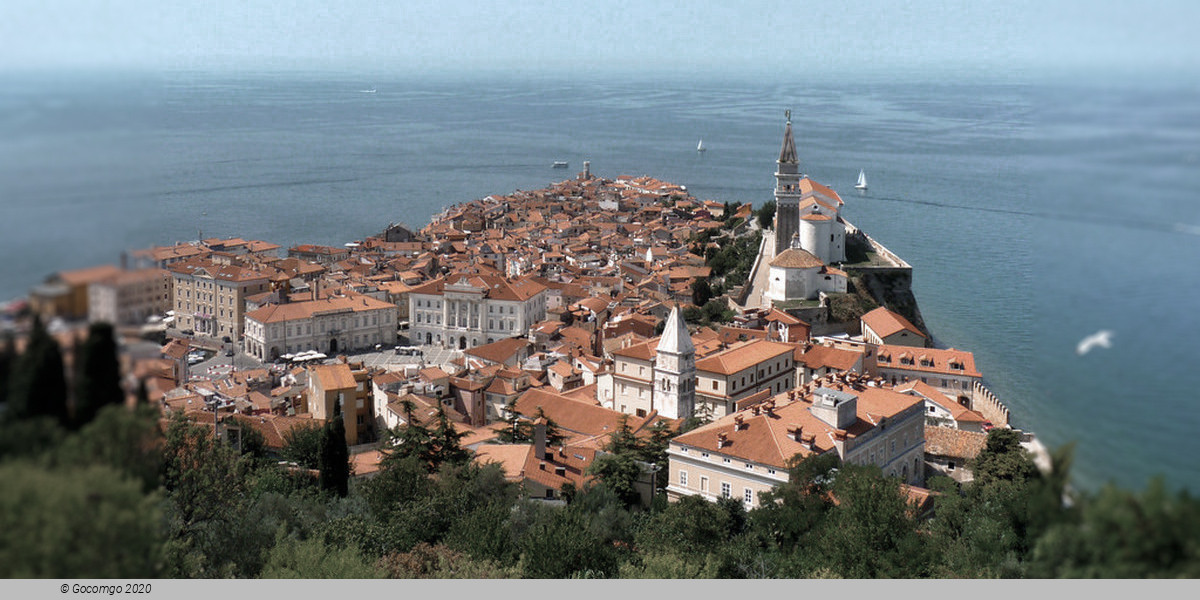Piran

Piran is a town in southwestern Slovenia on the Gulf of Piran on the Adriatic Sea. It is one of the three major towns of Slovenian Istria. The town is known for its medieval architecture, with narrow streets and compact houses. Piran is the administrative seat of the Municipality of Piran and one of Slovenia's major tourist attractions. Until the mid-20th century, Italian was the dominant language, but it was replaced by Slovene as demographics shifted.
History
The Piran peninsula was incorporated into the Roman Empire in 178 and 177 BC and settled in the following years with rural homes (villae rusticae).In the pre-Roman era, the hills in the Piran area were inhabited by Illyrian Histri tribes who were farmers, hunters and fishermen. They were also pirates who disrupted Roman trade in the northern Adriatic.
The decline of the Roman Empire, from the 5th century AD onward, and incursions by the Avars and Slavs at the end of the 6th century, prompted the Roman population to withdraw into easily defensible locations such as islands or peninsulas. This started local urbanization and by the 7th century, under Byzantine rule, Piran had become heavily fortified. Despite the defenses, the Franks conquered Istria in 788 and Slavs settled in the region. By 952, Piran had become a part of the Holy Roman Empire.
The earliest reliable records of the area are in the 7th-century work Cosmographia by an anonymous cleric of Ravenna. The name of the town most probably originates from the Greek "pyrrhos", which means "red", because of the reddish flysch stones commonly found in the town's area. Some historians also refer it to as "pyros", meaning fire, due to ancient lighthouses which were supposed to be on the edge of the marina.
From 1283 to 1797, the town became part of the Republic of Venice, where it was governed in a semi-autonomous way, with a council of local noblemen assisting the Venetian delegate. Several enemies (e.g. from the Republic of Genoa) and pirate assaults were repelled during the late Middle Ages; a great pestilence hit the town in 1558, killing about two-thirds of the population. The last decades of Venetian rule were marked by decadence, due to the competition with the nearby Austrian port town of Trieste.
The town was annexed to the Austrian Empire in 1797; but during the years from 1806 to 1814, it was ceded to the Napoleonic Empire. On 22 February 1812, the Battle of Pirano was fought between a British and a French ship of the line in the vicinity of Piran. This was a minor battle of the Adriatic campaign of the Napoleonic Wars.
At the end of the 19th century and the beginning of the 20th century, Piran was an Austro-Hungarian town with over 12,000 inhabitants, larger than nearby Koper. It was a flourishing market and spa town with good transport connections. The first trolleybus line in the Balkans was introduced to public service on 24 October 1909 in Piran. In 1912, it was replaced by a tramway that operated on the same route till 1953.
After the First World War, together with Trieste and all Istria, the town was ceded to Italy. There were no particular events in those years until Italy entered the Second World War in 1940. With the defeat of the Axis powers and the rise of Tito's rule, Piran was assigned to the Free Territory of Trieste, Zone B, under the Yugoslavian administration. The town was annexed to Yugoslavia in 1954, according to the London Memorandum signed together with Italy. A significant part of Piran's population chose to emigrate to Italy or abroad in the final phase of the Istrian exodus, rather than stay in socialist Yugoslavia. The annexation to Yugoslavia was finally ratified with the Osimo Treaty in 1975, signed by Italy as well. Since 1991, Piran has been part of independent Slovenia.
On 24 October 2010, Slovenia became the first country of former communist Europe to elect a black mayor. The physician Peter Bossman, who came from Ghana in the late 1970s, was elected the Mayor of Piran. He officially took office at the first constitutional meeting of the Municipal Council on 12 November 2010, succeeding Tomaž Gantar. He represents the Social Democrats.
The territorial claims of Croatia and Slovenia in the Gulf of Piran remain an important matter of debate in the Croatia–Slovenia border disputes that began after the dissolution of Yugoslavia.

